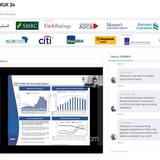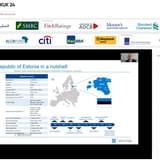What were some of the notable features of the euro-denominated covered bond issuance? What influenced the bank’s decision to be a first mover here?
There have long been discussions about issuing a covered bond denominated in euros, which had in turn influenced investors and started to shape their expectations – and questions – around what that would entail, but nobody had moved on it. Nevertheless, it became clear following discussions with international fixed income investors that there was growing demand for a residential mortgage backed covered bond issuance from Turkey, which is why VakifBank – which has a strong standing in the country’s capital markets – decided to move first. We tend to pride ourselves on being first movers in a number of respects: we were the first Turkish bank to establish a GMTN programme in 2013; the first Turkish bank to issue a euro-denominated Eurobond issuance in 2014; the first Turkish bank to issue Basel III-compliant Tier 2 notes in 2015 before. We hope to continue pioneering the Turkish capital markets.
This issuance was an important milestone not only for Turkey but for all emerging markets, increasing the appetite for others to follow suit and issue mortgage-backed covered bonds denominated in hard currencies.
 What kinds of challenges did you encounter in the run-up to launching the bond? How long did the whole process take?
What kinds of challenges did you encounter in the run-up to launching the bond? How long did the whole process take?
It was a tough process and took almost two years to prepare for the issuance. One of the elements worth mentioning is that we were contributing to the creation of Turkey’s covered bond regulations while preparing for our own issuance, which made the process both a challenge and opportunity for us at the same time. We had pushed hard for an investor-friendly structure and framework, something that took some time to achieve, but it also created a good opportunity for us to present our targets and expectations, and address our concerns to the Turkish regulator during the draft legislation process. We worked closely with Turkish regulators to ensure any final structure would meet our needs and the needs of the wider industry, which was a challenge, but we are encouraged by the fact that the regulators are keen to follow up with us and ensure capital market rules around covered bond issuance are continuously improved.
Can you take us through the marketing strategy on the covered bond?
Investors diversification was one of our main objectives. We did not just want to attract traditional emerging market fixed income investors – we also sought to tap into demand from global covered bond investors. As you can imagine, we also wanted to secure the best pricing possible. With an issuance credit rating that was three notches higher than the sovereign’s at the time, and our strong senior debt credit rating, we wanted to achieve meaningfully lower spreads – and have the robust structure of the instrument reflected therein.
Our initial focus was therefore on European investors. We organised a pan-European roadshow from April 5th until April 8th in Vienna, Munich, Frankfurt, London and Paris. We also held teleconferences with covered bonds investors based in other parts of Europe during the same week.
After the successful completion of the roadshow, investors were given a few days’ time to become familiar with the new structure and process their credit work for this debut trade.
What kind of feedback did you receive from investors?
Investor interest was largely concentrated in two areas. We discussed our residential mortgage portfolio and residential mortgage business at length. LTV ratios, durations, asset quality metrics, and average ticket sizes were all discussed in detail, and a lot of emphasis was placed on educating investors on the dynamics of the residential mortgage market in Turkey, which are quite different from those of most European markets. Some of the features unique to the residential mortgage business in Turkey – for instance, having no exposure to derivative products, a robust borrowing structure, no second or third-degree collateralization, and sole usage of house purchase proceeds were all credit-positives for investors.
The covered bond legal framework was also discussed in detail. The differences and similarities to European frameworks, particularly the German ‘Pfandbrief’ model, regular stress testing, overcollateralization ratios committed, and eligibility criteria for portfolio selection drew most of the attention.
Structurally, the embedded swap transactions with three different well-known European banks, which aim to mitigate currency and convertibility risk, were also welcomed by investors. The swaps were crucial for making investors comfortable with the transaction, and was necessary despite the fact it increased our total costs. It also helped us to secure a coveted ‘A3’ credit rating from Moody’s, which was the highest possible rating a Turkish issuer can get.
How was the transaction received after its launch?
The orderbook was opened on April 26th for a €500mn no-grow deal at IPTs of around MS+280bp. The market sounding strategy proved to be quite effective as the orderbook was already more than 2x covered within hours of its opening. The momentum continued and allowed us to tighten pricing by 15bp to MS+265bp area shortly thereafter. As the orderbook grew steadily with limited spread sensitivity from a vast number of accounts, the re-offer spread could be fixed at MS+250bp, resulting in a minimal pick-up of only 5bp to when compared to Turkish sovereign 5-year benchmark euro-denominated notes.
The success of the transaction clearly shows investors received the offering very well. We offered a good yield opportunity window to investors with a sound credit risk profile, and an instrument with a well-designed structure. This is also the lowest coupon achieved on any 5-year euro-denominated bond, including sovereign, in the Turkish market. Overall, we have carved out a new asset class in Turkey, as similar covered bond products above a certain maturity don’t provide comparable spreads.
Moving forward, we would like to come to the market at least once a year – market conditions permitting – and investors were very supportive of that. This is one reason why we established the covered bond programme. We are also keen to explore privately placed covered bond issuances in different tenors and currencies under the same programme, which should help further achieve our investor diversification goals.
We see huge potential in developing this market further, and would like to continue playing a pioneering role within it. During our own roadshow, we expressed the belief that covered bonds will eventually price inside the sovereign curve. It was 5bp wider than sovereign when we launched the transaction, but very shortly after the issuance, it started to trade tighter than the sovereign curve. In this sense, we are also happy to see that those bonds are performing well and that our forecasts proved accurate.
Do you think we are likely to see more covered bond issuance out of Turkey?
We will definitely see more Turkish covered bond issuers come to market, and we have already seen some peer banks reveal their own plans to launch transactions during their 2017 guidance calls.
As of today, VakifBank’s covered bond transaction is the one and only investment-grade euro-denominated market deal out of Turkey. But, the way that it is currently trading in the secondaries – inside sovereign – is increasing the appetite of other potential issuers.
These deals also have the potential to influence how investors perceive you. We feel our covered bond issuance, which has received a number of awards and critical acclaim from the industry, positively affected the perception of VakifBank in the eyes of investors and solidified our reputation as a leading bank and as a pioneer in the country’s capital markets. It has also motivated us to continue innovating in terms of how we target and capture a broader range of investors.









